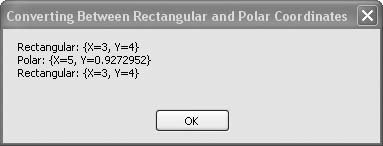Recipe 6.13. Converting Between Rectangular and Polar Coordinates
ProblemYou want to convert between two-dimensional coordinates expressed in either rectangular or polar notation. SolutionSample code folder: Chapter 06\ConvertPolar Create two functions for the two conversions: ToPolar() and ToRectangular(). DiscussionThe PointF structure provides a natural way to handle two-dimensional coordinates because each X, Y pair is handled as a single unit. A straightforward way to handle conversions between coordinates expressed in either rectangular (X, Y) or polar (radius, radians) notation is to simply pass and return PointF objects. This requires you, the programmer, to keep track of the current notation of each PointF object, but this is generally easy to do. Here are the two functions for making the conversions: Public Function ToPolar(ByVal sourcePoint As PointF) _ As PointF ' ----- Convert rectangular coordinates to polar. Dim magnitude As Single Dim radians As Single magnitude = CSng(Math.Sqrt(sourcePoint.X ^ 2 + _ sourcePoint.Y ^ 2)) radians = CSng(Math.Atan2(sourcePoint.Y, sourcePoint.X)) Return New PointF(magnitude, radians) End Function Public Function ToRectangular(ByVal sourcePoint As PointF) _ As PointF ' ----- Convert polar coordinates to rectangular. Dim X As Single Dim Y As Single X = CSng(sourcePoint.X * Math.Cos(sourcePoint.Y)) Y = CSng(sourcePoint.X * Math.Sin(sourcePoint.Y)) Return New PointF(X, Y) End Function Both functions assume angles will be expressed in radians, which is consistent with the way angles are expressed in Visual Basic. You can convert angles to and from degrees using the constants presented in Recipe 6.10. The following block of code demonstrates the use of the ToPolar() and ToRectangular() functions: Dim result As New System.Text.StringBuilder Dim pointA As PointF Dim pointB As PointF Dim pointC As PointF pointA = New PointF(3, 4) pointB = ToPolar(pointA) pointC = ToRectangular(pointB) result.AppendLine("Rectangular: " & pointA.ToString()) result.AppendLine("Polar: " & pointB.ToString()) result.AppendLine("Rectangular: " & pointC.ToString()) MsgBox(result.ToString()) The ToString() function presents the X and Y values of the PointF data using "X=" and "Y=" labels, which can be misleading when the PointF is holding a coordinate in polar mode. Be sure to keep track of the state of the data as you work with it. Figure 6-13 shows the formatted string results of the ToRectangular() and ToPolar() functions in action. Figure 6-13. Rectangular and polar two-dimensional coordinate conversions using PointF variables See AlsoSearching for " polar rectangular" on the Web will lead you to a variety of explanations and learning materials about this subject. |
EAN: 2147483647
Pages: 400